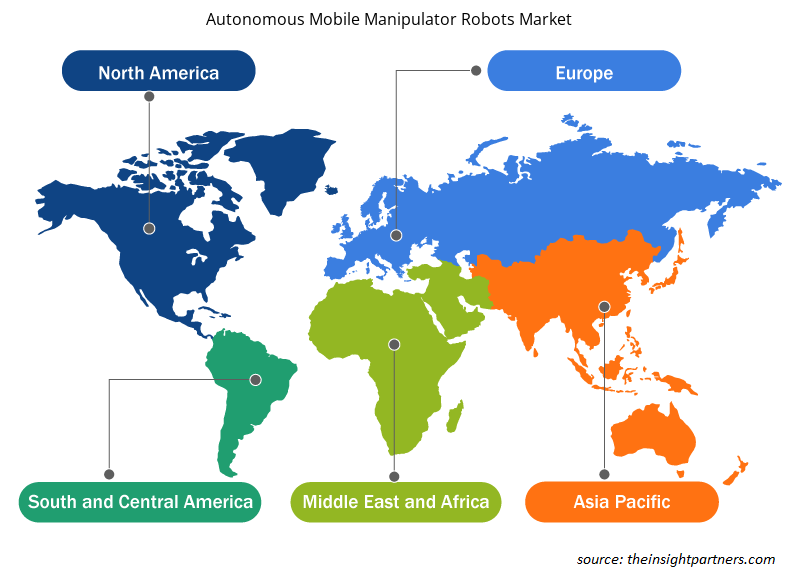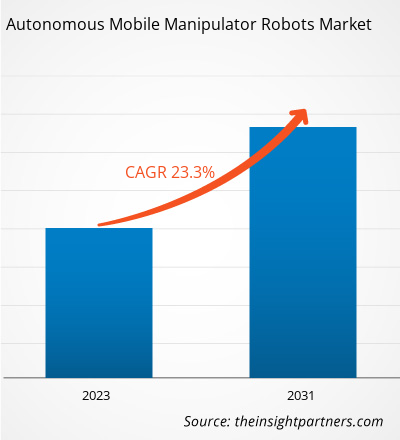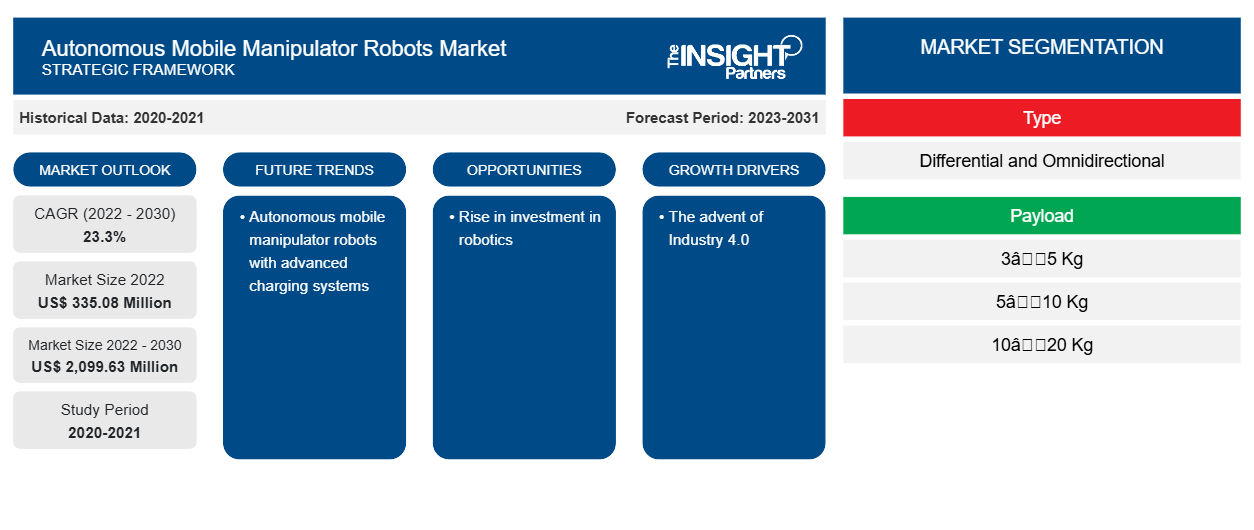Der Markt für autonome mobile Handhabungsroboter soll von 335,08 Millionen US-Dollar im Jahr 2022 auf 2.099,63 Millionen US-Dollar im Jahr 2030 anwachsen. Der Markt wird im Zeitraum 2022–2030 voraussichtlich eine durchschnittliche jährliche Wachstumsrate von 23,3 % verzeichnen. Die steigende Nachfrage nach automatisierten Systemen und die wachsende E-Commerce-Branche dürften weiterhin wichtige Trends auf dem Markt bleiben.
Marktanalyse für autonome mobile Manipulationsroboter
Die wachsende E-Commerce-Branche und das Aufkommen von Industrie 4.0 sind einige der wichtigsten Antriebsfaktoren für den Markt für autonome mobile Handhabungsroboter. Der Anstieg der Fabrikautomatisierung auf der ganzen Welt treibt das Marktwachstum an. Die Fähigkeit dieser Roboter, Objekte unterschiedlicher Größe, Form und Gewichte zu handhaben, trägt zu ihrer wachsenden Nachfrage in verschiedenen Endverbraucherbranchen wie Fertigung, Automobilindustrie, Logistik, Lagerhaltung und anderen bei.
Marktübersicht für autonome mobile Manipulationsroboter
Autonome mobile Manipulationsroboter (AMMR) sind eine Art autonomer mobiler Manipulationsroboter (AMR) mit einem montierten Roboterarm oder Manipulator. Diese Roboter integrieren die Manipulationsfähigkeiten eines Roboterarms mit der Mobilität einer mobilen Plattform. Sie können arbeiten, während sie sich bewegen und dabei Teilehandhabungsaufgaben wie Transportieren, Platzieren von Objekten oder Anheben ausführen. Autonome mobile Manipulationsroboter werden in der Logistik- und Lagerbranche häufig eingesetzt, um Waren zwischen Regalen oder Lagerbereichen zu transportieren. Die Fertigungsindustrie nutzt sie, um Materialien zu bewegen oder Teile autonom zwischen verschiedenen Arbeitsstationen zu manipulieren.
Passen Sie diesen Bericht Ihren Anforderungen an
Sie erhalten kostenlos individuelle Anpassungen an jedem Bericht, einschließlich Teilen dieses Berichts oder einer Analyse auf Länderebene, eines Excel-Datenpakets sowie tolle Angebote und Rabatte für Start-ups und Universitäten.
- Holen Sie sich die wichtigsten Markttrends aus diesem Bericht.Dieses KOSTENLOSE Beispiel umfasst eine Datenanalyse von Markttrends bis hin zu Schätzungen und Prognosen.
Autonome mobile Manipulationsroboter – Markttreiber und Chancen
Der Einzug von Industrie 4.0 kommt dem Markt zugute
Das Aufkommen von Industrie 4.0 in verschiedenen Branchen wie der Automobilindustrie, der Fertigung und anderen treibt den Einsatz von Robotern zur Ausführung sich wiederholender manueller Aufgaben voran. Der Einsatz von Roboterlösungen verschafft dem Unternehmen einen Wettbewerbsvorteil und trägt dazu bei, seine Produktionsleistung zu maximieren. Er trägt dazu bei, die Produktqualität zu verbessern und menschliche Fehler zu minimieren. Aufgrund der Notwendigkeit, ihre Anlagen zu automatisieren, setzen die Akteure der Branche in großem Umfang autonome mobile Manipulationsroboter ein, um Aufgaben wie Sortieren, Kommissionieren, Bewegen und andere auszuführen.
Anstieg der Investitionen in Robotik.
Weltweit gewinnt die Robotertechnologie an Popularität, da sie repetitive Aufgaben automatisieren und menschliche Fehler minimieren kann. Die Automatisierung der Prozesse hilft Unternehmen, ihre Produktionsfähigkeit und -kapazität zu steigern. Um diesem Ziel gerecht zu werden, investieren verschiedene Marktteilnehmer in fortschrittliche Technologie. Im April 2024 schloss Collaborative Robotics beispielsweise eine Serie-B-Finanzierungsrunde in Höhe von 100 Millionen US-Dollar ab, um seinen autonomen mobilen Manipulator auf den Markt zu bringen. Das in Santa Clara, Kalifornien, ansässige Unternehmen sagte, es entwickle Roboter, die sicher und kostengünstig neben Menschen in verschiedenen Arbeitsabläufen in der Fertigung, der Lieferkette und im Gesundheitswesen arbeiten können. In vielen Fällen handelt es sich um dieselbe Arbeit, um die sich humanoide Roboter reißen.
Marktbericht über autonome mobile Manipulationsroboter – Segmentierungsanalyse
Wichtige Segmente, die zur Ableitung der Marktanalyse für autonome mobile Manipulationsroboter beigetragen haben , sind Typ, Nutzlast, Anwendung und Endverbrauchsbranche.
- Basierend auf dem Typ wird der Markt für autonome mobile Manipulationsroboter in differentielle und omnidirektionale unterteilt. Das omnidirektionale Segment wird voraussichtlich mit der höchsten durchschnittlichen jährlichen Wachstumsrate wachsen.
- Nach Nutzlast ist der Markt in 3–5 kg, 5–10 kg, 10–20 kg und 20 kg und mehr segmentiert. Bei 20 kg und mehr wird das höchste CAGR-Wachstum erwartet.
- Nach Anwendung ist der Markt in Sortierung, Pick & Place, Bestandsverwaltung und andere unterteilt. Die Bestandsverwaltung hatte im Jahr 2022 einen erheblichen Marktanteil.
- Nach Endverbrauchsbranche ist der Markt in Gesundheitswesen , Raumfahrt, Montage und andere unterteilt. Die Montage hielt im Jahr 2022 einen erheblichen Marktanteil.
Marktanteilsanalyse für autonome mobile Manipulationsroboter nach Geografie
Der geografische Umfang des Marktberichts für autonome mobile Manipulationsroboter ist hauptsächlich in fünf Regionen unterteilt: Nordamerika, Asien-Pazifik, Europa, Naher Osten und Afrika sowie Süd- und Mittelamerika.
Der globale Markt für autonome mobile Handhabungsroboter wächst in europäischen Ländern aufgrund der Präsenz etablierter Automobilsektoren erheblich. Die Automobilhersteller automatisieren ihre Fertigungsanlagen, um ihre Produktivität zu steigern und wettbewerbsfähig zu bleiben, was die Einführung autonomer mobiler Handhabungsroboter vorantreibt. Darüber hinaus treiben staatliche Investitionen in die Digitalisierung und Automatisierung der Fertigungsindustrie das globale Wachstum des Marktes für autonome mobile Handhabungsroboter in Europa voran.
Regionale Einblicke in den Markt für autonome mobile Manipulationsroboter
Die regionalen Trends und Faktoren, die den Markt für autonome mobile Manipulationsroboter während des gesamten Prognosezeitraums beeinflussen, wurden von den Analysten von Insight Partners ausführlich erläutert. In diesem Abschnitt werden auch die Marktsegmente und die Geografie für autonome mobile Manipulationsroboter in Nordamerika, Europa, im asiatisch-pazifischen Raum, im Nahen Osten und Afrika sowie in Süd- und Mittelamerika erörtert.

- Erhalten Sie regionale Daten zum Markt für autonome mobile Manipulationsroboter
Umfang des Marktberichts über autonome mobile Manipulationsroboter
| Berichtsattribut | Details |
|---|---|
| Marktgröße im Jahr 2022 | 335,08 Millionen US-Dollar |
| Marktgröße bis 2030 | 2.099,63 Millionen US-Dollar |
| Globale CAGR (2022 - 2030) | 23,3 % |
| Historische Daten | 2020-2021 |
| Prognosezeitraum | 2023–2031 |
| Abgedeckte Segmente | Nach Typ
|
| Abgedeckte Regionen und Länder | Nordamerika
|
| Marktführer und wichtige Unternehmensprofile |
|
Dichte der Marktteilnehmer für autonome mobile Manipulationsroboter: Auswirkungen auf die Geschäftsdynamik verstehen
Der Markt für autonome mobile Manipulationsroboter wächst rasant, angetrieben durch die steigende Nachfrage der Endnutzer aufgrund von Faktoren wie sich entwickelnden Verbraucherpräferenzen, technologischen Fortschritten und einem größeren Bewusstsein für die Vorteile des Produkts. Mit steigender Nachfrage erweitern Unternehmen ihr Angebot, entwickeln Innovationen, um die Bedürfnisse der Verbraucher zu erfüllen, und nutzen neue Trends, was das Marktwachstum weiter ankurbelt.
Die Marktteilnehmerdichte bezieht sich auf die Verteilung von Firmen oder Unternehmen, die in einem bestimmten Markt oder einer bestimmten Branche tätig sind. Sie gibt an, wie viele Wettbewerber (Marktteilnehmer) in einem bestimmten Marktraum im Verhältnis zu seiner Größe oder seinem gesamten Marktwert präsent sind.
Die wichtigsten auf dem Markt für autonome mobile Manipulationsroboter tätigen Unternehmen sind:
- OMRON Corp
- Robotnik Automation SL
- Neobotix GmbH
- AgileX Robotics (Shenzhen) Ltd.
- Kuka AG
- Hans Laser Technology Co Ltd
Haftungsausschluss : Die oben aufgeführten Unternehmen sind nicht in einer bestimmten Reihenfolge aufgeführt.

- Erhalten Sie einen Überblick über die wichtigsten Akteure auf dem Markt für autonome mobile Manipulationsroboter
Marktnachrichten und aktuelle Entwicklungen für autonome mobile Manipulationsroboter
Der Markt für autonome mobile Handhabungsroboter wird durch die Erhebung qualitativer und quantitativer Daten nach Primär- und Sekundärforschung bewertet, die wichtige Unternehmensveröffentlichungen, Verbandsdaten und Datenbanken umfasst. Nachfolgend sind einige der Entwicklungen auf dem Markt für autonome mobile Handhabungsroboter aufgeführt:
- Hello Robot hat Stretch 3 auf den Markt gebracht, einen vollständig integrierten mobilen Manipulator, der von überall aus über einen Webbrowser gesteuert werden kann. Er interagiert mit Menschen mithilfe eines leichten Körpers. Dank seiner kompakten Grundfläche von 33 x 34 cm kann er sich im Durcheinander und in engen Gängen echter Häuser zurechtfinden. Dank seiner geringen Masse und Kontaktempfindlichkeit kann Stretch sicherer in der Nähe von Menschen eingesetzt werden. Stretch verfügt über einen großen Arbeitsbereich, der den Boden, einen Couchtisch und die Rückseite eines Schranks umfasst. (Quelle: Hello Robot, Pressemitteilung, Februar 2024)
- Comau kündigte im Rahmen von drei verschiedenen europäischen Projekten die Entwicklung einer leistungsstarken mobilen Roboterplattform als Teil einer offenen, hochgradig kollaborativen Produktionsumgebung an. Die integrierte Lösung, die Comaus bewährte Expertise in IoT-fähigen Technologien und kollaborativer Robotik nutzt, ist eine natürliche Weiterentwicklung der automatisierten Workflow-Optimierungssysteme des Unternehmens. Die Plattform ist modular, skalierbar und vollständig neu konfigurierbar und kann problemlos an verschiedene Anwendungen angepasst werden, ohne die zugrunde liegende Software- oder Hardwarearchitektur des Systems zu ändern. (Quelle: Comau, Pressemitteilung, März 2023)
Marktbericht zu autonomen mobilen Manipulationsrobotern – Abdeckung und Ergebnisse
Der Bericht „Marktgröße und Prognose für autonome mobile Manipulationsroboter (2020–2030)“ bietet eine detaillierte Analyse des Marktes, die die folgenden Bereiche abdeckt:
- Marktgröße und Prognose für autonome mobile Manipulationsroboter auf globaler, regionaler und Länderebene für alle wichtigen Marktsegmente, die im Rahmen des Berichts abgedeckt sind
- Markttrends für autonome mobile Manipulationsroboter sowie Marktdynamik wie Treiber, Einschränkungen und wichtige Chancen
- Detaillierte PEST/Porters Five Forces- und SWOT-Analyse
- Marktanalyse für autonome mobile Manipulationsroboter mit Abdeckung der wichtigsten Markttrends, des globalen und regionalen Rahmens, der wichtigsten Akteure, der Vorschriften und der jüngsten Marktentwicklungen
- Branchenlandschaft und Wettbewerbsanalyse, die die Marktkonzentration, Heatmap-Analyse, prominente Akteure und aktuelle Entwicklungen auf dem Markt für autonome mobile Manipulationsroboter umfasst
- Detaillierte Firmenprofile
- Historische Analyse (2 Jahre), Basisjahr, Prognose (7 Jahre) mit CAGR
- PEST- und SWOT-Analyse
- Marktgröße Wert/Volumen – Global, Regional, Land
- Branchen- und Wettbewerbslandschaft
- Excel-Datensatz
Aktuelle Berichte
Verwandte Berichte
Erfahrungsberichte
Grund zum Kauf
- Fundierte Entscheidungsfindung
- Marktdynamik verstehen
- Wettbewerbsanalyse
- Kundeneinblicke
- Marktprognosen
- Risikominimierung
- Strategische Planung
- Investitionsbegründung
- Identifizierung neuer Märkte
- Verbesserung von Marketingstrategien
- Steigerung der Betriebseffizienz
- Anpassung an regulatorische Trends























 Kostenlose Probe anfordern für - Markt für autonome mobile Manipulatorroboter
Kostenlose Probe anfordern für - Markt für autonome mobile Manipulatorroboter